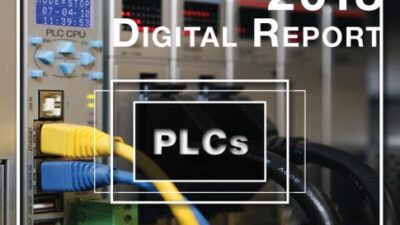Input and output (I/O) module manufacturers are not resting on their laurels. The unsung devices that are tucked away in enclosures and scattered about the plant floor are seeing steady improvement in communications, integration ease, and density. Not only do I/O modules provide the necessary connections between sensors or actuation devices and the site of control logic, thereby closing the co...
To read an expanded version of this article click here.
Input and output (I/O) module manufacturers are not resting on their laurels. The unsung devices that are tucked away in enclosures and scattered about the plant floor are seeing steady improvement in communications, integration ease, and density.
Not only do I/O modules provide the necessary connections between sensors or actuation devices and the site of control logic, thereby closing the control loop, they also are adaptable to a variety of communication protocols, physical constraints, and physical-layer connections. I/O modules, like all other control system devices, must be applicable to in-plant expansions and control-system revamps.
Built-in scalability, flexibility, and backward compatibility are considered prerequisite, and are qualities reflected in the products described below. I/O module manufacturers have done their homework and continue to provide control engineers with a variety of versatile connectivity devices.
Trends in I/O modules were explored in an August 2004 email/Web survey by Control Engineering and Reed Research Group—both part of Reed Business Information. The study queried subscribers about preferences in I/O devices, including technological preferences and purchasing patterns. Results were based on 177 qualified responses from readers involved in specifying, recommending, and/or buying I/O devices.
Let’s network!
According to survey results, the ‘ability to network as a very important reason to specify and buy I/O devices’ took a dramatic jump from the previous survey done 1.5 years ago—up to 57% from 47%, while most other characteristics remained about the same (see accompanying bar graph). Connie Chick, business manager for controllers at GE Fanuc, explains the growing interest in networking, especially in continuous process, by saying, ‘In the process world, high availability is critical; no DCS runs without it. Anything, such as smart devices, that can help that process stay up makes the investment extremely worthwhile.’
So what is on the horizon for I/O module technology? According to Larry Komarek, automation product manager for Phoenix Contact, I/O form factors are evolving and incorporating new connection and communications technology to lower the installed costs for more application situations.
‘In the past, only PLC rack mount I/O modules were available. Now both machine OEM and manufacturing process users employ modular manufacturing approaches that consist of using standardized function assemblies, each containing the control, mechanics, and software routines,’ Komarek says.
Connection and communications technology innovations are fueling I/O system innovations. Examples of this include slice-style modular I/O connection schemes that reduce I/O station wiring time by eliminating countless module-to-module wires required by traditional rack I/O devices. For IP65/67 I/O systems, new M12 connectors are emerging that reduce connection time by up to 90% by connecting in less than one turn vs. many turns for conventional M12 systems.
Demise of 4-20 mA?
Survey results said Ethernet TCP/IP was the communication network most often cited for respondent’s current and future I/O networking needs. The old standby, 4-20 mA, was second choice in both categories. According to Todd Walter, data acquisition group manager for National Instruments, this response is not unexpected. ‘In recent years, there has been a significant trend in the automation market to adopt PC-based technologies and standards. The boom of the computer in office and consumer applications has created reliable and low-cost components that have been heavily leveraged by the automation market. Ethernet has become the de facto network communication standard for the PC, and has also been adopted by the automation market,’ Walter notes.
I/O Products
For more manufacturers, visit www.controleng.com/buyersguide ; for system integrators, www.controleng.com/integrators . Also visit the Web sites listed.
Flex I/O family expands
| Rockwell Automation |
By expanding its family of Allen-Bradley Flex modular I/O products, Rockwell Automation has given system designers and end-users more connectivity, enhanced diagnostic capabilities and new options and certifications that meet the needs of hazardous-location applications. The line now includes 8-point input (IE8H) and output (OE8H) HART analog modules that allow communication with ‘smart field’ devices that support the popular HART protocol. Modules can access the HART digital signal in parallel to the module’s 4-20 mA analog signal with no effect on analog-signal processing. Modules allow users to connect to ControlNet or EtherNet/IP networks, HART field devices, HART handheld programming terminals, controllers, human-machine interface (HMI), and Field Device Tool (FDT)-compatible software. www.rockwellautomation.com
Rockwell Automation
Link I/O, PC via Ethernet
| AutomationDirect |
T1H-EBC100 module provides a high-performance Ethernet link between the company’s Terminator I/O products and PC-based control software, or WinPLC/DL205/DL405 CPUs using its Ethernet Remote Master module. The module supports TCP/IP, UDP/IP and IPX at 10/100 Mbps. It also supports Modbus TCP protocol, said to be the most widely used open protocol in industrial manufacturing, at 10/100 Mbps. The module can be configured using an Internet browser to access the module’s HTML configuration page. This configuration method uses the TCP/IP protocol, and the module’s IP address must be known to establish communications. NetEdit3 software can be used to verify the module’s IP address and to configure the module. www.automationdirect.com
AutomationDirect
Ethernet process control, distributed wireless I/O
| Moore Industries-International |
When wires can’t be run for practical or economic reasons, the Wireless Link Module (WLM) provides accurate and reliable wireless connectivity between remote field sites. This bi-directional, spread-spectrum wireless module employs Intelligent Spectrum Frequency Hopping technology and 32-bit CRC error correction for secure, robust communications. Available models support Ethernet or serial communications, and operate at FCC license-free frequency ranges of 902 to 928 MHz or 2.4 to 2.483 GHz. The WLM is ideal for use with its developer’s NCS NET Concentrator System (NCS), as well as similar process control and distributed I/O systems. www.miinet.com
Moore Industries-International Inc.
High-performance I/O family
| Schneider Electric |
Telemecanique Advantys OTB is the latest addition to a family of modular distributed I/O products from Schneider Electric. These I/O devices have been optimized for use in modular distributed I/O architectures. Advantys OTB are also said to meet the requirements of machine manufacturers and users who seek the best compromise between size, ease of installation/cabling and costs. Open and modular, these I/O solutions enable OEM manufacturers to create small and medium-sized I/O islands, managed by a master controller over a fieldbus or communications network. Distributing I/O devices and logic closer to sensors and actuators reduces wiring time and costs for modular machines. Three module communication bases work with CANopen, Ethernet TCP/IP, or Modbus RS-485. www.us.telemecanique.com
Schneider Electric
Smart I/O terminals for DeviceNet
| Omron Electronics |
Users can monitor more than I/O status using DRT2 ‘smart’ DeviceNet slave terminals. Available as discrete, analog, and IP67 sealed-discrete input and output modules, DRT2 slaves collect valuable information that can be used in preventive maintenance programs to reduce unexpected shutdown due to component failure. Users can also remotely monitor automatically collected data using Omron’s DeviceNet Configuration Software. All devices offer communications supply voltage monitoring and a communications error log. www.omron.com
Omron Electronics LLC
Universal analog I/O module
| GE Fanuc |
PACSystems RX3i Universal Analog module offers functionality of four modules in one to reduce I/O space requirements, decrease spare parts and inventory, and simplify wiring and configuration. It also provides up to 30 types of analog input configurations. Channels can be individually-configured using Proficy Machine Edition software for developers, providing any combination of up to 8 channels of voltage, current, thermocouple, RTD, and resistance inputs. Modules are software-configurable, require no module jumpers to set, provide six filter frequencies, and are individually selectable by channel. www.gefanuc.com
GE Fanuc
Next generation of multifunction DAQ devices
| National Instruments |
National Instruments now offers a new generation of multifunction data acquisition (DAQ) products based on the newly designed NI-STC 2 system controller chip and NI-PGIA 2 amplifier technology. M Series multifunction DAQ devices offer increased accuracy, faster sampling rates, more I/O channels, and features previously unavailable in multifunction DAQ devices. These devices are said to lower the cost per I/O channel and reduce overall system costs by minimizing setup time using development tools included in NI-DAQmx measurement services driver software. Applications include test, control, and sensor measurement. www.ni.com
National Instruments
I/O system upgrade
| ABB Automation Technologies |
ABB offers a same-footprint to its original automation I/O system. S400-to-S800New units have the same footprint and field-cable connector socket locations as the old ones, simplifying replacement. Existing field cable need not be changed or relocated. www.abb.se.com
ABB Automation Technologies
Distributed I/O provides IP20 protection
| Siemens Energy & Automation |
Siemens Energy & Automation’s Simatic ET 200S distributed I/O now delivers IP 20 field-level protection for Ethernet. ET200S can now use Profinet, the Profibus International industrial Ethernet offering. Profinet is real-time Ethernet that encompasses all aspects of automation, including I/O, motion, machine cell connectivity, and safety. When combined with Siemens IM 151-3 PN ProfiNet interface, the ET 200S I/O operates as distributed I/O controlled via Ethernet, including analog signals, counters, serial interfaces, motor starters, frequency converters and pneumatics. www.sea.siemens.com
Siemens Energy & Automation
High-density input module
| Opto 22 |
Snap-HDIDC-32, a 32-channel digital input module, is used with Opto 22’s Snap Ethernet systems for local and remote monitoring, discrete manufacturing, process control, and data acquisition applications. Snap-HDIDC-32 is said to offer a new level of density for users with high digital I/O point count applications, or for those who require more than 64 points in a single location or I/O rack. The module also reduces the per-point cost of digital I/O systems by providing up to eight times the number of I/O channels in the same space. It provides 32 optically isolated channels of status input. www.opto22.com
Opto 22
Inline block-style I/O modules
Block I/O modules include 16- and 32-channel digital block modules and are compatible with a number of fieldbus protocols including Interbus, Profibus DP, DeviceNet, CANOpen. The compact design of the Inline Block I/O modules allows them to be easily installed in distributed control panels or control cabinet doors. The 2-in. high Inline Block I/O modules are said to be ideal for smaller control cabinets. Installation is said to be easy; I/O and communications are integrated into one low-cost unit. www.phoenixcon.com
Phoenix Contact Inc
Capture upset events
Sequence of Events (SOE) I/O cards are used to capture process-upset events from field devices. Because events are captured and temporarily stored locally on the SOE I/O card, faster recording is possible for each channel on the card. Events captured by an SOE input card are time stamped using www.emersonprocess.com
Emerson Process Management
Combination I/O module
Model ET-MIX24880-D has a double-density design that provides 24 discrete inputs and/or eight discrete outputs, and eight analog inputs in a single compact module. ET-MIX24880-D joins the family of EtherTrak I/O modules while providing direct Ethernet and/or RS485 connectivity, which can be used as a redundant backup communication path. Use of the new ET-MIX24880-D instead of individual modules for each I/O type, saves space, reduces installation time, and lower costs. The module has a 16-bit A/D converter for precision measurements and hot-swap capability. www.sixnetio.com
Sixnet


